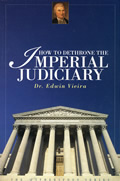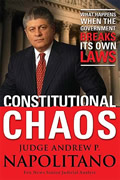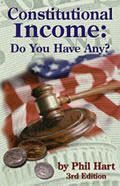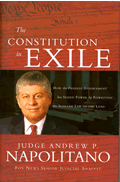THOUGHTS
ON PART TWO OF “A CONCURRING OPINION”
PART 2
By
Dr. Edwin Vieira, Jr., Ph.D., J.D.
March 3, 2010
NewsWithViews.com
In responding to Timothy Baldwin’s “A CONCURRING OPINION FOR SECESSION (Part 2)”, I should first clarify a few points:
It is many secessionists’ position, but not mine, that the Constitution is “a contract between the States and the General Government” or “a contact among the States”. I reject the former theory, because, inasmuch as the Constitution created the General Government from nothing, the General Government could not possibly have engaged in any “offer and acceptance” with the States (or anyone else)in order to form the Constitution. I reject the latter theory, because the Constitution does not say that “We the States of New York, Rhode Island, Virginia, and so on” “do ordain and establish this Constitution”. Neither does it say that “We the People of the States of New York, and so on” “do ordain and establish this Constitution”. Rather, it says that “We the People of the United States” “do ordain and establish this Constitution”, which is something quite different from the first two alternatives. Thus, the Constitution is what political philosophers call a “social contract” among an entire people, not just a “contract” or “compact” among discrete entities called “States”, and therefore is more binding than such a “contract” or “compact”. But, for purposes of some of this discussion, I am quite willing to assume, along with the “secessionists”, that the Constitution is simply a “contract” among the States—because, as I have pointed out, their own argument on that score does them more harm than good.
When (in my previous article) I mentioned the “detrimental-reliance” rationale for the binding nature of contracts, it was to provide a general background on principles of contract-law for lay readers of these articles, not to argue that the legality of some State’s “secession” from the Union absolutely depends upon whether the “seceding” State has suffered or will suffer some grievous harm from her adhesion to the Union. It is fairly obvious that, in adhering to the Constitution since 1788, the States have radically changed their positions from what those positions would have been in the absence of the Union—Article I, Section 10 of the Constitution alone proves that. But the questions relating to “secession” which are of interest to me are: (i) Is “secession” legal under the Constitution, whether or not the “seceding” State has been or will be harmed by being or remaining in the Union? And (ii) if “secession” were legal, under the present circumstances in which this country finds itself would “secession” cause so much harm to the States, including even the “seceding” State herself, as to be an imprudent course of action? After all, if (as seems obvious) “secession” is legal under Article V of the Constitution, it could occur even if the dissenting one-fourth of the States were harmed by it, or if none of the States were harmed by it, or even if all of the States were harmed by it. But whether it were sensible to promote “secession” at all would depend upon one’s prediction of what and how much harm might ensue from it.
Now, addressing Mr. Baldwin’s points:
1. Mr. Baldwin writes that “[t]o avoid the conclusion that the US Constitution is simply a non-binding agreement upon the States, Vieira points us to ‘what lawyers call’ detrimental reliance, offering a sort of alternative to the ‘contract/compact’ theory of secessionists”. In my view, however, “detrimental reliance” is not “a sort of alternative to the ‘contract/compact’ theory of secessionists”, but part of the explanation for the binding nature of contracts in general. Anyone who enters into a contract thereby deprives himself of certain degrees of freedom, on the expectation that the other parties to the contract will adhere to the agreement. That deprivation, in and of itself, is “detrimental reliance”, even if the other parties never “breach” the contract or if the other parties’ “breach” of the contract should result only in what lawyers call “nominal damages”. In any event, as I pointed out before, neither I nor anyone else should have any difficulty in “avoid[ing] the conclusion that the US Constitution is simply a non-binding agreement upon the States”, because the binding nature of the Constitution is explicitly set out in the Constitution itself, in Article VI. As I explained in my initial article in this discussion, if the States can act only through their officers, and if (under Article VI), each and every one of those officers “shall be bound by Oath or Affirmation, to support this Constitution”, then the States must be “bound”, too. Certainly, if words have meaning, no one can discover “a non-binding agreement upon the States” in a “supreme Law” that explicitly holds all of the States’ officers “bound”.
2. Mr. Baldwin argues that “[t]he detrimental reliance theory * * * is not at all in order as it relates to the independent actions of independent states. Is the United States perpetually bound by a treaty to a foreign country forever where that country has materially breached the agreement?”
Well, the answer to that question depends upon the specific terms of the particular agreement, does it not? Certainly even “independent states” can (and do) make treaties that are to some degree binding on them. And they can (and do) provide in treaties the procedures by which those treaties may be amended, modified, extended, terminated, renegotiated, renounced, annulled, and so on. And they can (and do) define in treaties what constitutes “breaches” thereof, and who will be the judge of the occurrence of a “breach”, and what remedies will be available to the non-“breaching” party. Of course, the “breach” of a treaty might be so extensive that it would be impossible for the injured party to use the methods for redress stipulated in the treaty. But to know whether that is the case, one must first identify those methods and then compare the “breach” to them.
In any event, I doubt that Mr. Baldwin is contending that the Constitution is nothing but a “treaty” among “independent States” (a position held by vanishingly few “secessionists” these days). Yet, even if he does so contend, the Constitution contains a provision for amending, or even terminating, the supposed “treaty”: namely, Article V. So the “independent States” are not “perpetually bound” to the “treaty”, although they are bound to some degree. The question then becomes: Is the alleged “breach” of the Constitution so gross that Article V no longer provides an adequate remedy for the aggrieved States? Or Article III? Or some other provision of the Constitution? That is, why should the actual terms and conditions of the supposed “treaty” themselves not be consulted, and if at all possible applied, before the “treaty” is denounced as hopelessly violated, and some remedy with potentially extremely deleterious consequences is invoked?
And who is it, in Mr. Baldwin’s view, who has “materially breached the agreement”, and whose “breach” justifies the “secession” of some State? Is it the General Government, which is not a party to the “agreement” at all, being a mere product of the “agreement”? Or is it one or more of the States? Or is it some part of “We the People” who “ordain[ed] and establish[ed] th[e] Constitution” in the first place, as its Preamble attests? In devising remedies for “breaches” of “agreements”—whether “treaties”, “contracts” “compacts”, or some other arrangements—it is necessary first to identify all of the parties to the agreement, and then to single out the malefactors among them and of precisely what their wrongdoing consists.
3. Mr. Baldwin correctly points out that “[n]ot one state expressly conditioned their ratification of the constitution upon the guarantee that all of the ratifying states (present and future) will be bound to that union, even though all of the states knew of its possibility”. But no principle of contract-law requires that the parties to a contract expressly condition their agreement upon such a “guarantee”. The binding nature of a true contract on all of the parties is always presumed from the agreement itself, even if the contract is silent on that score (as most contracts are). Nonetheless, in Article VI of the Constitution (as in Article XIII of the Articles of Confederation), this “guarantee” does exist. Plainly enough, when the States ratified the Constitution they knew full well that they were acceding to a document which expressly required that all of their officers “shall be bound by Oath or Affirmation, to support this Constitution”. The Preamble sets out as its very first goal “to form a more perfect Union”—“more perfect”, that is, than the “Union” under the Articles of Confederation, Article XIII of which declared to be “perpetual”, unless certain procedures in that Article were followed. So, to what conclusion could any State have come, other than the Constitution itself provided “the guarantee that all of the ratifying states (present and future) will be bound to that union”, and that her ratification of the Constitution was an acceptance of that situation?
4. Mr. Baldwin correctly points out that “[t]hey [i.e., the States] joined the union based on the moral force of commonality”. That motive does not detract, however, from the legally binding force of the Constitution. People enter into contracts for all sorts of reasons—“commonality”, consanguinity, the hope of a sharp dealer that he has fleeced a sucker, and so on. But their reasons are almost always irrelevant. (If the reasons were, say, to facilitate a criminal act, then the contract would be void ab initio.) If the agreement satisfies the standards of a “contract”, then it is binding on the parties.
5. Mr. Baldwin then asks, “how can it be that the colonies had a right to secede from Great Britain which was a bond connected by a monarchy with no form of voluntary union present, but there can be no right to secede in a federal compact formed voluntarily by sovereign states?” Actually, the Colonists’ theory of their political connection to, and rights as against, the British Monarchy was a bit more complex than Mr. Baldwin makes it out to be. See, e.g., Declaration of the Causes and Necessity of Taking Up Arms (6 July 1775). But, in any event, as the Colonists themselves “submitted to a candid world”, their right to “secede” depended on the existence of the particular, rather extreme conditions the Declaration of Independence identified. The Declaration did not contend that the Colonists had an absolute right to “secede” from Great Britain for just any reason, at any time, at their own unilateral discretion, and even if the government of Great Britain were a “just government” that had not “become[ ] destructive of [men’s unalienable Rights]”. Rather it listed reason after reason that proved the existence of “a long train of abuses and usurpations * * * evinc[ing] a Design to reduce the[ Colonists] under absolute Despotism”. Doubtlessly, if the very same conditions existed today as existed then, some or all of the States could claim a right, and even a duty, to “secede”. But the question is: Do those conditions exist today? That they do may be an allegation that many contemporary “secessionists” make. But, in light of the seriousness of the consequences of any attempt at “secession”, something more substantial in the way of actual evidence is needed, and should be required.
6. Mr. Baldwin argues that “each colony had the individual decision to make for itself whether or not it would secede [from Great Britain], and they maintained that independence from each other as evidence[d] by their Declaration to the world of being free and independent states, having all the powers that independent nations have. If there is anything that is clear from the Declaration of Independence period, it is that the people wanted to maintain a federal form of government, not a national one”. But American history did not end with “the Declaration of Independence period”. Far from “maintain[ing] th[eir] independence from each other”, even before 1776 the States had united in fact to fight Great Britain, and thereafter codified that union in law with the Articles of Confederation and the Constitution. Moreover, in the Articles and the Constitution, We the People did maintain “a federal form of government”. It happens, under both documents, to be “a federal form of government” which sets out specific procedures plainly relevant to “secession”. But where is it written that “a federal form of government” cannot incorporate such procedures, or that if it does so they may simply be disregarded? And if such notions were written somewhere else, they were most assuredly not written into the Articles of Confederation or the Constitution, which are the controlling documents for the purposes under discussion here (unless and until a “Declaration of Independence situation” arises). That every “federal form of government” known throughout prior history, bar none, had allowed for unlimited “secession” would prove nothing more than that the Constitution is a new form of “federal government”. Are not Americans entitled to innovate in that field?
7. Mr. Baldwin properly points out that “the natural and contract law principles of course work both ways: where a state has entered the union with the promise or assurance that the fundamental laws, principles and purposes of the constitution be followed, then the harmed state has the right to seek remedy for that breach and to mitigate its damages as far as possible for the preservation of that state where those guarantees are not followed”. Yet this tells us nothing about what procedure the aggrieved State should follow to achieve those ends, either as a matter of law or under the counsel of prudence. Moreover, it begs the questions of whether “the [allegedly] harmed state” is actually “harmed”, who is to decide that matter, and what remedies are available to redress the State’s injuries. In addition, what of the other States? As Mr. Baldwin says, these principles “work both ways”. So, if one State has a right to “secede” (under whatever procedure) when “the fundamental laws, principles and purposes of the constitution” are not followed, do not the other States have just as valid a right to prevent that State from “seceding” when she acts in violation of “the fundamental laws, principles and purposes of the constitution”? For example, assume that (say) the State of South Carolina seeks to “secede”. Under Article V, that State has a plain constitutional right to petition Congress to propose an amendment, or to ask the legislatures of other States to call for a convention, for that purpose. But if South Carolina is not successful in this endeavor, yet attempts to “secede” anyway, the rest of the States can claim a right to prevent her “secession”—perhaps through the General Government, by seeking indictments on charges of perjury or false swearing against the officers of South Carolina who violate their constitutional “Oath[s] or Affirmation[s]” of office by promoting “secession”, or perhaps through more direct action even as the Northern States did in the 1860s.
8. Mr. Baldwin then quotes from the State of New York’s ratification of the Constitution,
That all Power is originally vested in and consequently derived from the People, and that Government is instituted by them for their common Interest Protection and Security.* * * * *
That the Powers of Government may be reassumed by the People, whensoever it shall become necessary to their Happiness * * * .
Documents Illustrative of the Formation of the Union of the American States, House Document No. 398, 69th Congress, 1st Session (Washington, D.C.: Government Printing Office, 1927), at 1034. He might also have quoted the ratification of the State of Rhode Island,
That all power is naturally vested in, and consequently derived from the People; that magistrates therefore are their trustees and agents, and at all times amenable to them.
* * * That the powers of government may be reassumed by the people, whensoever it shall become necessary to their happiness[.]
Id. at 1052. From New York’s ratification, Mr. Baldwin concludes that “[h]ere, New York put the world on notice that the people and their agents (state government) retain the right to withdraw themselves from political associations where such unions become destructive to the ends of government”. But where in the ratifications of either New York or Rhode Island does any mention of “state government” appear? The ratifications say that “the powers of government may be reassumed by the people”. And to which “people” do these ratifications refer? Mr. Baldwin assumes—quite gratuitously, I must suggest—that the ratifications refer to “the people” of New York or Rhode Island alone. But these were not the only “people” who were responsible for ratifying the Constitution. Rather, the Constitution itself says that “We the People of the United States” as a whole “do ordain and establish this Constitution”. Thus, these were “the people” to whom New York must have referred when she said “That all Power is originally vested in any consequently derived from the People”—for the power to “ordain and establish” the Constitution was not vested in, and did not derive from, only the people of New York, but in and from all of We the People. And these were “the people” to whom New York must have referred when she said “that Government is instituted by them”—for the Constitution (the only charter of “Government” involved in the process of ratification) was not instituted by the people of New York alone, but by all of We the People, as the Constitution itself declares and which New York’s ratification of the Constitution affirms. So, the only way that the ratifications of New York and Rhode Island can be squared with the Constitution is to read them in precisely the opposite manner from that proffered by Mr. Baldwin—to say, not that individual States may “secede” from the Union ad libitum, but that only We the People as a whole may change the government that We the People created, thereby excluding individual States from the unilateral exercise of that authority.
Rather compelling proof of this conclusion comes from Virginia’s ratification, which stated:
We the Delegates of the People of Virginia * * * Do in the name and in behalf of the People of Virginia declare and make known that the powers granted under the Constitution being derived from the People of the United States may be resumed by them whenever the same shall be perverted to their injury or oppression[.]
Documents Illustrative of the Formation of the Union of the American States, at 1027. With the usual care for legal niceties characteristic of her statesmen in that era, leaving nothing to implication, Virginia made a crystal-clear distinction between “the People of Virginia” and “the People of the United States”, and plainly held that “the powers granted under the Constitution [were] derived from the People of the United States”, not just “the People of Virginia” or of any other State unilaterally; and that those powers “may be resumed by them”, that is, “the People of the United States”, not just “the People of Virginia” or of any other State unilaterally.
So, these documents do not support Mr. Baldwin’s sweeping assertion that New York’s (or Rhode Island’s, let alone Virginia’s) ratification asserted an unilateral “‘right [of each State] to withdraw’” on her own initiative from the Constitution. As Mr. Baldwin himself correctly states, “[y]ou cannot attempt to justify a position based on the constitution when the documents ratifying the constitution show the opposite political intent and effect. * * * One cannot look at the words today and apply his own subjective meaning to them. This contradicts every rule of sound construction.”
9. Finally, Mr. Baldwin concludes that,
[i]f detrimental reliance is the pad-lock holding the states together, then it most certainly is the key to unlock the states’ part in the union where the system of the union itself causes detriment to the states, such that a state’s very survival and freedom’s perpetuation is best accomplished through secession from the existing union. As soon as this theory is admitted, contract laws necessarily appear between the states and with the created federal government * * * .
| Subscribe to the NewsWithViews Daily News Alerts! |
But one can admit this theory for the purposes of argument without thereby agreeing that “a state’s very survival and freedom’s perpetuation is best accomplished through secession from the existing union”, either always or at the present time. Depending on circumstances, “a state’s very survival and freedom’s perpetuation” could be most threatened “through secession”. This proved to be the case for the Southern States in the 1860s, and could just as well be the case today.

















